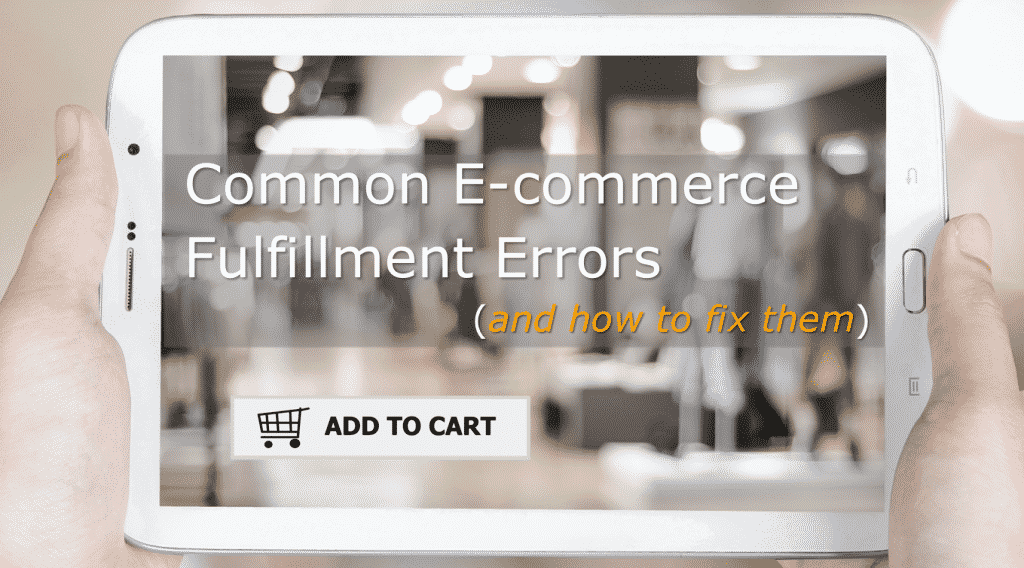Common E-commerce Fulfillment Errors (and How to Fix Them)
In 2016, e-commerce is undeniably the most popular way to connect customers with the products they love. That makes e-commerce fulfillment the base on which great online brands are built. So far, so simple.
Building the kind of fulfillment solution that satisfies online customers every time they order is not nearly as easy. There are plenty of pitfalls on the road to growing a successful e-commerce site. Many of these revolve around the challenge of getting your goods to customers as quickly and cost-effectively as possible, which is also where errors start to creep in.
As we focus this month on the rise of e-commerce and how to handle this dynamic shift in the supply chain, let's look at some of the more common e-commerce fulfillment mistakes and what you can do to avoid them.

Common E-commerce Fulfillment Errors
If you've spent any time processing and shipping orders placed online, you'll have some idea of just how many errors can occur along the way.
The ease with which a sales site can be created often belies the complexity of its underlying structure. Expansive product ranges can be listed in seconds, but maintaining their information and managing the physical product shipments requires a lot of preparation and coordination.
To address the kinds of errors that you can expect to encounter as you set up or develop an e-commerce fulfillment solution, we've broken potential issues down to three main categories:
- Administrative Errors
- Pricing Issues
- Shipping Oversights
Let's take a look at each of these concerns in more detail.
Admin Errors
The most mundane form of errors is sadly also the most commonplace and, in many cases, the ones that cost you more. Without close attention to detail and accurate inventory management, it's likely you'll see administrative errors sooner rather than later.
Furthermore, the cost can be greater than simply resolving the error.
The loss of trust and declining brand reputation that results from multiple errors is far more damaging in the long run.
Some examples of common admin errors include:
- Items listed as available but out of stock after placing an order.
- Product weight or dimensions inaccurate.
- Incorrect quantities listed or added to the order.
- Wrong item(s) shipped.
- Any informational error that leads to incorrect ordering or confuses your customer.

Pricing Issues
There's little that puts customers off quite as much as messing with the price they expect to pay. Even the slightest alterations during the ordering process or additional charges at checkout can lead to a KPI spike that you never want to see: soaring cart abandonment rates.
Consider some of these common situations in which pricing quickly become an issue:
- Data errors leading to incorrect pricing.
- Outdated coupons or failing to honor advertised pricing.
- Sudden price increases, often arising from inaccurate forecasts or shipping calculations.
- Applying the wrong shipping calculation to your cost modeling and/or ordering system.
- Failing to update your ordering system when shipping costs change.
According to Kiss Metrics, unexpected shipping charges are the number one reason given by online shoppers for cart abandonment. It's always important to factor the cost of shipping into your profit margin calculations, but never forget to let your customers know what they can expect right from the outset.
Shipping Oversights
If you ordered anything online over the holidays, you'll know just how much e-commerce fulfillment relies on shipping policies to deliver the goods.
That's not just literally speaking, either. Free or low-cost shipping plays a major role in attracting shoppers to e-commerce sites. Conversely, it can also turn customers away when S&H costs start to rise, or when an order fails to arrive as expected.
Here are some common shipping issues to consider:
- Carrier selection and service levels.
- Packaging cost and quality.
- Failure to explore hybrid shipping and drop shipping options.
- Failing to clearly distinguish shipping address section from billing address.
- High rates of damage in transit.
- Ability - or lack of it - to track a package in transit.
- Failure to log actual shipping costs and compare them to forecasts.
Take Steps to Fix E-commerce Fulfillment Errors
If you recognize any of the issues above in your own organization, or simply fear they may arise in future, now is the time to act. By spotting the potential for fulfillment mistakes early on in it becomes much cheaper to fix the issue and, more importantly, it reduces the risk of long-term damage to your brand.
Administrative errors are the first to face up to. This is because they tend to be the most embarrassing but are often easily resolved.
Challenge your employees to own their area of work and report any concerns. We touched on this in our "going to Gemba" article last year, but this is even more targeted on individual duties and flagging errors that were previously overlooked.
Sometimes simply highlighting the damage that these errors can do to the business is enough to catalyze significant improvements.
Cutting out existing admin errors and setting regular reviews to catch new issues as they arise is one of the most immediate steps you can take to improve your e-commerce fulfillment.
In terms of pricing, it's vital to acknowledge that your decisions will always be a balancing act between converting customers and sufficiently covering your costs. A first step is to look at your expenses and identify any areas that can be trimmed without significantly impacting customer satisfaction. As described above, cutting out administrative errors can be a quick way to achieve this, at the same time as improving your brand reputation.
If you have any inkling that your cost models might not be accurate, review them immediately and run different forecasts across different product lines to ensure you don't overlook any aspects of your pricing model. Shipping errors overlap with this process. Research different shipping costs and packaging
Shipping errors overlap with this process. Research different shipping costs and packaging solutions. For example, hybrid delivery solutions are one way to reduce shipping costs, if you can afford to lose some visibility in the final mile of delivery. A change in packaging can also change the weight and dimension of your product shipments, with a subsequent impact on cost and the final price you present to your customer.
We covered many of these areas in our Fulfillment Fundamentals presentation last year, which you can view in full below.
The following articles will also provide some valuable deeper reading on ways to adjust your shipping costs:
- 7 Steps You Can Take to Reduce Shipping Costs
- Unpacking: Hybrid Delivery Solutions
- The Advantages of Drop Shipping
If you're struggling to raise the service level of your e-commerce fulfillment, Capacity can help.
Contact us today or mail information@capacityllc.com with your questions. One of our experts will get back to you to fix any errors and get your brand back on track.